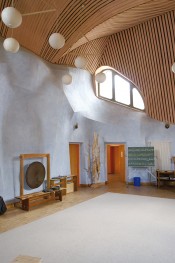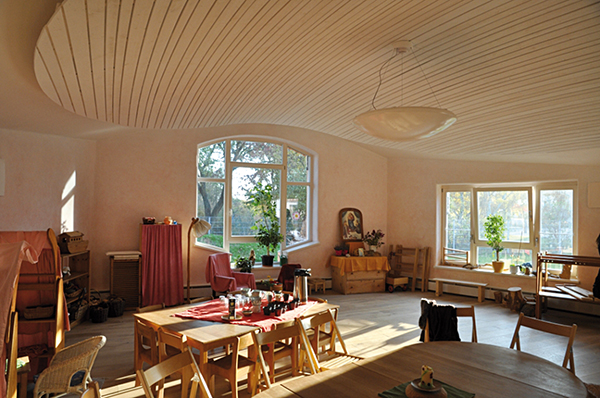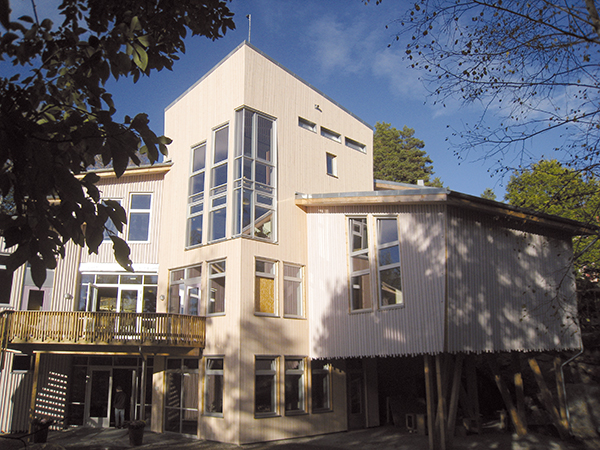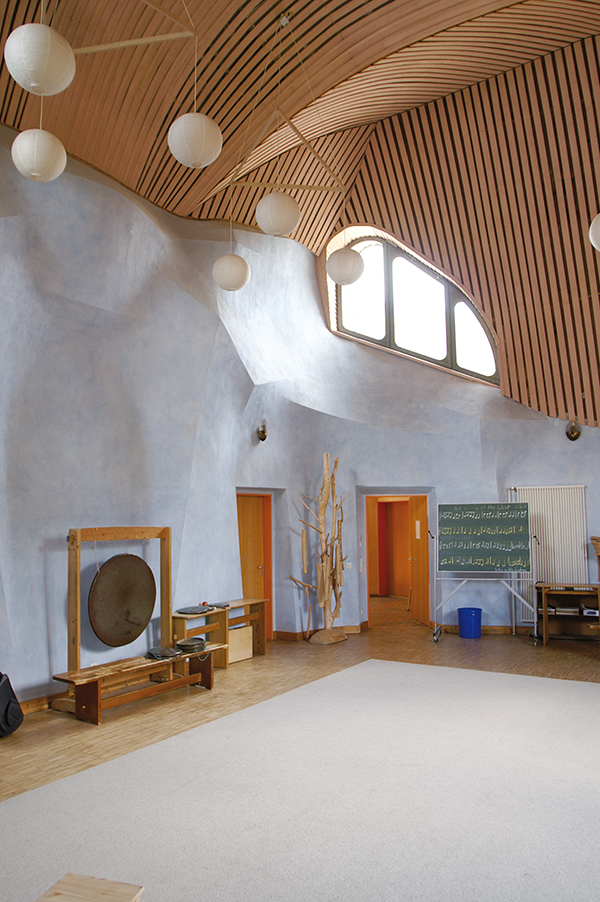Waldorf News
Human Beings as the Measure of Things: On the architecture of Waldorf schools

By Matthias Mochner, July 2014
Waldorf education accords particular importance to the architecture of its schools. Because real art should create a relationship between human beings and the spirit. The space in which the art of education is realised between teachers and pupils is not a work of art in itself but the architecture of Waldorf schools can create a framework in which teaching becomes possible as an artistic process.
If it is true that school buildings should not be an obstacle to education as an artistic process, then the dictum of some Waldorf schools not to build “anthroposophically” as far as possible is counterproductive in three ways. First, it ignores educational necessity; second, it denies the historical stream of the architectural development of Waldorf schools; and third, it propagates the preconception that the architecture of Waldorf schools essentially consists of “no right angles”. For decades, almost any design that has been built in the architecture of our time has been publicly highly praised, particularly as today it is possible from a technical construction perspective and in terms of materials to build almost any desired structure. The concepts applied make use of the vocabulary of organic architecture with increasing frequency.
The transparency of walls (mostly glass), the relationship of the building to the (built) environment and, not least, the view that architecture should build with people in mind are global guiding criteria for describing a contemporary architecture based on values. But if we put these criteria to the test by examining the concrete effects of such buildings on the human being as a whole (starting with the research of Christian Rittelmeyer in the 1980s for example), it becomes clear how abstract and divorced from reality such praise really is.
One particularly serious example is the Phaeno Science Centre near the railway station In Wolfsburg built by the architect Zaha Hadid. After the building was opened, an additional space had to be built in which visitors could recover their inner equilibrium after they had become physically sick because of the many sloping walls and slanting floors. According to the British newspaper The Guardian, the structure nevertheless belongs to the twelve most important modern buildings. Against this background, which illustrates the dire situation of current architecture, but also its desire to penetrate into wholly new spatial qualities, Waldorf schools are justifiably entitled to point to the common architectural impulse which underlies their school buildings. By reflecting on the substance of their architecture, which can be developed afresh out of Rudolf Steiner’s anthroposophy in each individual case, they are setting standards not just in education but also in school architecture.

Kindergarten Leipzig, Markurt Architekturkontor, Leipzig - Architekturbüro Denker & Zimmer, Berlin.
Is Waldorf aware of the special nature of its architecture?
Buildings which formed a constituent part of the as yet unwritten history of the architectural development of Waldorf schools have been replaced by new ones. There are good reasons for that. But it is also a fact that the vitality and originality of the architecture of Waldorf schools is on the wane. Many school communities end up with a perhaps in the end only mediocre school building under the most difficult financial circumstances. And such lack of distinction has an effect – despite all the love and effort.
Because the human organism always responds, consciously or unconsciously, to the built reality. In order to become aware of this as an adult, we only need to ask ourselves in a building how we really feel in it: secure, abandoned, depressed, ignored and pushed aside as a person, miserable, downcast; or at home, inspired and lifted far beyond ourselves so that we encounter ourselves in a new way?
Then there is something else: the conditions under which children and young people incarnate today have changed. It is meanwhile medically undisputed that the outer reality surrounding human beings is developing in a direction in which the individual is constantly subject to shock-like effects (for example attending daycare facilities at too early an age) which trigger traumatic or trauma-like processes which in turn lead to a rise in cardiac disease. Is it not an obvious step to investigate what the architecture of a Waldorf institution should be like in order to mitigate, contain or indeed transform these effects occurring, for example, during the not inconsiderable time of 16,000 hours that a child will spend in school? Where else if not in Waldorf institutions, where the living spirit is sought, investigated and practiced in education, should the impulse for an architecture in harmony with the human being come to appearance?
Architecture acts on the moral constitution
It is of course true that new construction of Waldorf schools should not copy the past. But the values of the past can nevertheless be transformed and grasped in a new way in the present. I am convinced that the necessity of a living architecture is much greater now than in the early twentieth century. The scope of Rudolf Steiner’s conviction that truly good architecture can have a healing effect as far as into the moral constitution of the human being is becoming increasingly clear in view of the technologisation and digitalisation of the relationship between the I and the world. To create something new in this sense is the task of the coming years.
Steiner referred to “stylistic forms of organic vitality” which can be created out of the living forces of nature, and against the background of the cultural epochs he spoke about “construction forms as thoughts with which to obtain a sense of culture and the world”. By bringing their own soul development to consciousness, human beings are faced with the task of grasping their own relationship with the spirit in a concrete and individual form. They can no longer rely on the intellectually plausible polarity of good and evil but have to find an equilibrium between dissolving and hardening tendencies within themselves. That is the new element.
This struggle can also be observed in architecture. What relationship does the building create between the human I and the world? Does a building merely reflect the one-sidedness of our cognitive and rationally intellectual civilisation or does it testify to a culture of building in which humans as threefold beings can develop harmoniously both physically as well as in their soul and, ultimately, spirit? From such a perspective we can ask: how are today’s “thoughts with which to obtain a sense of culture and the world” articulated in school buildings? In answering this question, it is crucial to understand the concept of the relationship between the I and the world in a spiritual sense and not just to relate it to sensory reality (of the building). Only when the physical building succeeds in bringing its users by means of sensory perception into a relationship with the spirit which is appropriate for the whole of their development, can we truly refer to “construction forms as thoughts with which to obtain a sense of culture and the world”.
Because all architecture is subject to a law which Paul Schatz (1898-1979), the discoverer of eversion, formulated in discussion with the engineer Wolfgang Gessner (1881-1974) in 1956: “Everything that is created is the truest expression of the forces at work. Even if some building appears to later critics as a crime against architecture when measured against what existed as the basis in ideas for the task at hand at the time it was built, the building that took shape could – as we know – only give expression to the possibilities open to the then elite to the extent that such possibilities created a resonance in the community. All buildings reveal the constitution in which a society finds itself like a mirror which does not lie.”

Waldorfschool Moss Norway / Architects: Winfried Reindl, Imme Denker, Joachim Zimmer.
The building as the mirror of the community
The task of making oneself capable of resonating with the “forces at work” was characterised as follows by the architect Jens Peters who built the hall of the Stuttgart-Uhlandshöhe Waldorf school together with Johannes Billing and Nikolaus Ruff: “Working together and structuring it organically is an essential part of architecture itself. Architecture cannot be realised on one’s own, many people always have to work together. The shape of the building reveals how well people worked together. The most important thing in the community is creating a common awareness; that is, the common awareness of all processes irrespective of whoever actually carries them out.” He expanded on that in 2003 in the essay “Eurythmy and Architecture”: “Our buildings, the architectural gestures, have to learn from the gestures of eurythmy if they are gradually to communicate their laws to users…” Eurythmy utilises the “forces at work” in the etheric sphere. Where in Waldorf school architecture is the attempt currently being made to come to terms with the etheric? If we wanted to give examples, something that is always one-sided, we could cite the upper school building of the Waldorf school in Moss (2013) in Norway or the straw bale and cob-built Waldorf kindergarten in Leipzig (2011).
Jens Peters wrote to the author in 2013: “It is necessary to work our way into metamorphosis to obtain an understanding that the introduction of the idea of metamorphosis to architecture represents a mystery act.” A profound reasoning underlies what might appear to some as a presumptuous formulation. A completely new dimension of thinking about architecture is opened up which goes beyond the usual discussion about what is “organic,, “living” or “anthroposophical” in architecture: creating a connection with a mystery impulse means placing oneself individually into the continuity of a spiritual stream in awareness of one’s responsibility towards the spiritual world as a school.
The concept of metamorphosis, which did not exist in architecture before Steiner, implies that a specific form in a building always relates in an inner, lawful relationship to the overall form of the building. Metamorphosis prevents arbitrariness in architecture – just as the shape of the hand, the foot or the head are not the actual human being but each of these forms only make sense in a specific place in the context of the human organism to offer the human spirit an adequate dwelling in the physical sphere. The introduction of this concept to architecture created the possibility of bringing the laws of what is built on a physical plane in turn – in a contemporary way – into harmony with spiritual laws.
A good school building is an expression of the soul and spiritual life of a specific school community. Since the age of the people for whom it is built comprises a span of almost two septenniums, it requires forms which are appropriate for the life rhythms occurring between starting in kindergarten and leaving school. In its best buildings, Waldorf school architecture develops spatial qualities which overcome the arbitrariness in the language of forms of contemporary architecture, assigns their proper place to right-angles and squares and allows for an experience of what is living through, for example, double curved surfaces. Thanks to the Swedish colour designer Fritz Fuchs (and others), it possesses immense experience in artistic colour design for various functional rooms. This wealth of experience can serve as a model – without this having been particularly noticed in contemporary architecture. It is about the experience of the timeless relevance of buildings.
If we ask about central themes, they can be found in the eleven stylistic criteria set out in the book Dornach Design by Reinhold Johann Fäth – as a resource, not as a programme.
One thing particularly distinguishes the architecture of Waldorf schools in so far as they are new builds: it seeks in a deeper sense to make the human being its measure.
About the author: Matthias Mochner is a freelance journalist, speaker and study tour guide. He is the editor of the journal ‘Mensch und Architektur’ and board member of Internationales Forum Mensch und Architektur, Deutschland e.V. He has been studying the life and work of Paul Schatz since 2006 and is currently working on a publication about biodynamic agriculture.
This article originally appeared at www.erziehungskunst.de, the online portal of the journal Erziehungskunst, which is published by the Association of Waldorf Schools in Germany. To view the article at source, just click here. Many thanks to Erziehungskunst for permission to share this article with you.

Widarschule Bochum-Wattenscheid / Architect: Klaus Rennert (Photo: Mathis Lohl)
 Summer Programs - Culminating Class Trips
Summer Programs - Culminating Class Trips Waldorf Stories for Everyone
Waldorf Stories for Everyone Flexible preparation for your new grade
Flexible preparation for your new grade Bringing Love to Learning for a Lifetime
Bringing Love to Learning for a Lifetime Train to Teach in Seattle
Train to Teach in Seattle Middle School Science With Roberto Trostli
Middle School Science With Roberto Trostli Jamie York Books, Resources, Workshops
Jamie York Books, Resources, Workshops The Journey is Everything
The Journey is Everything Waldorf-inspired Homeschool Curriculum
Waldorf-inspired Homeschool Curriculum ~ Ensoul Your World With Color ~
~ Ensoul Your World With Color ~ Grade Level Training in Southern California
Grade Level Training in Southern California Everything a Teacher Needs
Everything a Teacher Needs Transforming Voices Worldwide
Transforming Voices Worldwide Waldorf Training in Australia
Waldorf Training in Australia Caring for All Stages of Life
Caring for All Stages of Life Bay Area Teacher Training
Bay Area Teacher Training Roadmap to Literacy Books & Courses
Roadmap to Literacy Books & Courses Quality Education in the Heartland
Quality Education in the Heartland Great books for Waldorf Teachers & Families
Great books for Waldorf Teachers & Families Training in Traumatology & Artistic Therapies
Training in Traumatology & Artistic Therapies Immersive Academics and Arts
Immersive Academics and Arts Space speaks. Its language is movement.
Space speaks. Its language is movement. Full-Time Teacher Education
Full-Time Teacher Education Association for a Healing Education
Association for a Healing Education Preparing Teachers for 2024-25 Grades 1-8
Preparing Teachers for 2024-25 Grades 1-8 Grade-specific web courses for teachers
Grade-specific web courses for teachers RSS Feeds
RSS Feeds